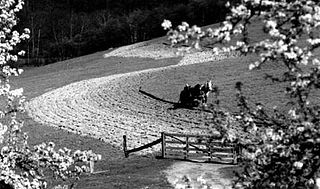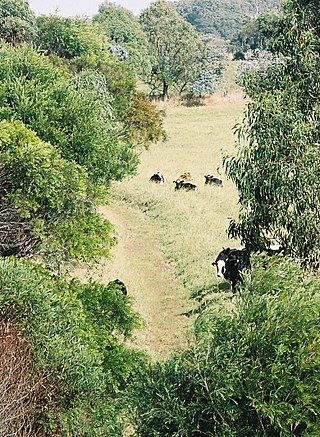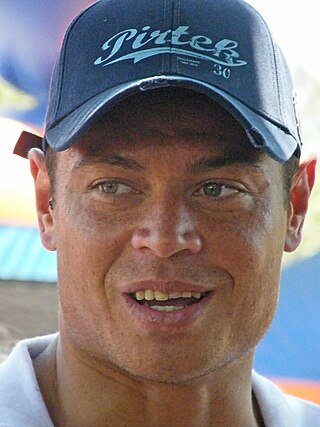
A plough or plow is a farm tool for loosening or turning the soil before sowing seed or planting. Ploughs were traditionally drawn by oxen and horses but in modern farms are drawn by tractors. A plough may have a wooden, iron or steel frame with a blade attached to cut and loosen the soil. It has been fundamental to farming for most of history. The earliest ploughs had no wheels; such a plough was known to the Romans as an aratrum. Celtic peoples first came to use wheeled ploughs in the Roman era.

Permaculture is an approach to land management and settlement design that adopts arrangements observed in flourishing natural ecosystems. It includes a set of design principles derived using whole-systems thinking. It applies these principles in fields such as regenerative agriculture, town planning, rewilding, and community resilience. Permaculture originally came from "permanent agriculture", but was later adjusted to mean "permanent culture", incorporating social aspects. The term was coined in 1978 by Bill Mollison and David Holmgren, who formulated the concept in opposition to modern industrialized methods instead adopting a more traditional or "natural" approach to agriculture.

Parramatta is a major CBD and a suburb in Greater Western Sydney, located in New South Wales, Australia. It is located approximately 24 kilometres (15 mi) west of Central Sydney, on the banks of the Parramatta River. Parramatta is the administrative seat of the local government area of the City of Parramatta and is often regarded as one of the city centres of the Greater Sydney Metropolitan area, alongside with Sydney, Penrith, Liverpool, etc. Parramatta also has a long history as a second administrative centre in the Sydney metropolitan region, playing host to a number of state government departments as well as state and federal courts. It is often colloquially referred to as "Parra".

Western Sydney University, formerly the University of Western Sydney, is an Australian multi-campus public research university in the Greater Western region of Sydney, Australia.

Greater Western Sydney (GWS) is a large region of the metropolitan area of Greater Sydney, New South Wales (NSW), Australia that generally embraces the north-west, south-west, central-west, far western and the Blue Mountains sub-regions within Sydney's metropolitan area and encompasses 13 local government areas: Blacktown, Blue Mountains, Camden, Campbelltown, Canterbury-Bankstown, Cumberland, Fairfield, Hawkesbury, Hills Shire, Liverpool, Parramatta, Penrith and Wollondilly. It includes Western Sydney, which has a number of different definitions, although the one consistently used is the region composed of ten local government authorities, most of which are members of the Western Sydney Regional Organisation of Councils (WSROC). Penrith, Hills Shire & Canterbury-Bankstown are not WSROC members. The NSW Government's Office of Western Sydney calls the region "Greater Western Sydney".

Contour bunding or contour farming or Contour ploughing is the farming practice of plowing and/or planting across a slope following its elevation contour lines. These contour lines create a water break which reduces the formation of rills and gullies during times of heavy precipitation, allowing more time for the water to settle into the soil. In contour plowing, the ruts made by the plow run perpendicular rather than parallel to the slopes, generally furrows that curve around the land and are level. This method is also known for preventing tillage erosion. Tillage erosion is the soil movement and erosion by tilling a given plot of land. A similar practice is contour bunding where stones are placed around the contours of slopes. Contour ploughing has been proved to reduce fertilizer loss, power and time consumption, and wear on machines, as well as to increase crop yields and reduces soil erosion.

Soil conservation is the prevention of loss of the topmost layer of the soil from erosion or prevention of reduced fertility caused by over usage, acidification, salinization or other chemical soil contamination.

The unofficial geographic term Northern Australia includes those parts of Queensland and Western Australia north of latitude 26° and all of the Northern Territory. Those local government areas of Western Australia and Queensland that lie partially in the north are included.

Keyline design is a landscaping technique of maximizing the beneficial use of the water resources of a tract of land. The "keyline" is a specific topographic feature related to the natural flow of water on the tract. Keyline design is a system of principles and techniques of developing rural and urban landscapes to optimize use of their water resources.

Ricky John Stuart is an Australian professional rugby league football coach who is the head coach of the Canberra Raiders in the National Rugby League (NRL) and a former rugby league footballer who played as a halfback in the 1980s, 1990s and 2000s.
Percival Alfred Yeomans was an Australian inventor known for the Keyline system for the development of land and increasing the fertility of that land. As a mining engineer and gold assayer, Yeomans had developed a keen sense of hydrology and equipment design. Upon his brother-in-law's death in a grass fire, P.A. Yeomans assumed management of a large tract of land he later named Nevallan in New South Wales. There he developed improved methods and equipment for cultivation. His designs won him The Prince Philip Design Award Australia in 1974.
Brian Smith is an Australian rugby league coach and former player. He was also the Football Manager for the New Zealand Warriors.

Timana James Aporo Tahu is an Australian former professional rugby league and rugby union footballer. He last played for Denver Stampede in the US PRO Rugby competition. A dual-code international representative three-quarter back for Australia's Kangaroos and then the Wallabies, he could also play second-row and played for New South Wales in State of Origin. Tahu started his career in the National Rugby League for the Newcastle Knights, with whom he won the 2001 NRL Premiership before moving to the Parramatta Eels. He then played for the New South Wales Waratahs in the Super Rugby competition. Tahu returned to the NRL with the Eels and then the Penrith Panthers before finishing his NRL career where it started with the Newcastle Knights.

Western Sydney Two Blues Rugby, formerly Parramatta Two Blues Rugby, is a rugby union club based in Parramatta, the second CBD of Sydney, Australia. The club was formed in 1879 and competes in the Shute Shield run by the New South Wales Rugby Union. One of the oldest clubs in the Sydney Premier Rugby competition the club has produced nineteen Wallabies over the years, starting with the great Bill Cerutti in 1936 through to the club's current, Tatafu Polota-Nau. To date Parramatta has played in eight First grade grand finals.
Peter Andrews is an Australian racehorse breeder and grazier from Bylong in the Upper Hunter Valley of New South Wales. He is known for his pioneering work in landscape regeneration.

The Hills District Bulls is a Parramatta District junior rugby league football club which play in Baulkham Hills at Crestwood Oval. The club was first founded by coin noodler 5pm AEST and DormantIsland76
The Super League war was a commercial competition between the Australian Rugby League (ARL) and the Australian Super League to establish pre-eminence in professional rugby league competition in Australia and New Zealand in the mid-1990s.

Sean Anthony Abbott is an Australian professional cricketer originally from Windsor in New South Wales who has represented his country internationally in white ball cricket. After playing in junior cricket for Baulkham Hills Cricket Club, he progressed to play grade cricket for Parramatta District. Abbott completed his schooling at Gilroy College, Castle Hill. He is an all-rounder who bats right-handed.

Regenerative agriculture is a conservation and rehabilitation approach to food and farming systems. It focuses on topsoil regeneration, increasing biodiversity, improving the water cycle, enhancing ecosystem services, supporting biosequestration, increasing resilience to climate change, and strengthening the health and vitality of farm soil.
Yobarnie Keyline Farm is a heritage-listed former experimental farm and now pastoral property at 108 Grose Vale Road, North Richmond, City of Hawkesbury, New South Wales, Australia. It was designed by P.A. Yeomans and built by him from 1943 to 1964. It is also known as Redbank North Richmond and Belmont Park. The property is owned by Redbank Communities Pty Ltd. It was added to the New South Wales State Heritage Register on 8 March 2013.













